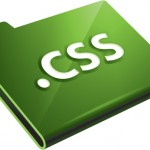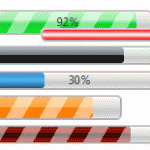Responsive Design: How To Use CSS3 Flex Box

“CSS offers several tools to help with site layout. Over the years we’ve worked mainly with floats, positioning, and margins, but let’s face it, most of us would like more. Fortunately css3 is giving us more tools for layouts. One of those tools is the flexible box.
A couple of weeks ago .net magazine published an article on The future of css layouts, in which they covered several new css3 layout modules. I’d like to work through some of them starting today with the flexible box layout module.
I’ve created a demo page illustrating some of the properties of the flexbox, though there’s not much to see in the demo that you can’t see from the images throughout this post. It’s there in case you want to play around with the source code.”
How to Create Graphical File Upload Progress Bars Using HTML5 and JavaScript

“In my previous posts, we discovered How to Use HTML5 File Drag & Drop, Open Files Using JavaScript and Asynchronously Upload Files Using Ajax. In the final part of this series, we cover the most exciting part of the process: graphical progress bars!
File upload progress bars provide essential user feedback but they’ve been notoriously difficult to implement. Until now that is. Both Firefox and Chrome support the XMLHttpRequest2 object which offers a progress event handler. But first, let’s consider how our progress bar will be implemented…”
Tutorial: Getting Started With jQuery Animations

“jQuery. No doubt you have heard about this popular JavaScript library. It has taken the throne of all the JavaScript libraries out there because of its many features and easy syntax. Today, I will show you one of the simpler uses of jQuery: you can animate things. this will be the focus of today’s tutorial.
Before we begin, you should learn one very important thing: this next snippet of code.”
Extending the Functionality of WordPress (Part 2)

“Previously, we brought you a handful of ways to expand on the functionality of any WordPress based site using some inspired plugins and/or themes to elevate this CMS beyond its humble beginnings as a blogging platform. With ways to turn WP into a Discussion Forum, an Online Shop, and a Helpdesk. Today, that mission continues.
Excerpt from Part One
Theme designers and plugin developers have been pushing the boundaries of what WordPress can do for some time. This has accelerated since the introduction of Custom Post Types into the WordPress core as it allows developers to use WordPress in a lot of weird and wonderful ways.
Today we will begin showing you examples of themes and plugins that let you use WordPress in ways you may have never thought possible.
As we mentioned last week, in this installment we will show you how to extend the possibilities of your WP site to make it a Wiki, an Arcade, a Job Board, a Membership based site, a Review site, or just a Q&A site. Now let’s get at it.”
How To Create Flexible Images And Media In CSS Layouts

“A flexible layout isn’t all that flexible if some of the component parts are fixed. Text easily reflows as it’s container resizes, but what about images and other media? How do we make them flexible to keep our layout flexible?
Last week we talked about elastic layouts and flexible grids. Next week we’ll look at media queries. We’re building toward responsive layouts by discussing each of the 3 parts necessary for responsive design in a separate post.
All the credit here belongs to Ethan Marcotte and I recommend his post on flexible images. I also highly recommend Ethan’s new book on responsive design.
Also Richard Rutter has set up a page experimenting with flexible images using max-width that’s worth checking out.”
Why You Should Start Using HTML5 & CSS3 Today

“For a while now, we have taken notice of how many designers are reluctant to embrace the new technologies such as CSS3 or HTML5 because of the lack of full cross-browser support for these technologies. Many designers are complaining about the numerous ways how the lack of cross-browser compatibility is effectively holding us back and tying our hands keeping us from completely being able to shine and show off the full scope of our abilities in our work. Many are holding on to the notion that once this push is made, we will wake to a whole new Web full of exciting opportunities just waiting on the other side. So they wait for this day. When in reality, they are effectively waiting for Godot.
Just like the elusive character from Beckett’s classic play, this day of full cross-browser support is not ever truly going to find its dawn and deliver us this wonderful new Web where our work looks the same within the window of any and every Web browser. Which means that many of us in the online reaches, from clients to designers to developers and on, are going to need to adjust our thinking so that we can realistically approach the Web as it is now, and more than likely how it will be in the future.
Sometimes it feels that we are hiding behind the lack of cross-browser compatibility to avoid learning new techniques that would actually dramatically improve our workflow. And that’s just wrong. Without an adjustment, we will continue to undersell the Web we have, and the landscape will remain unexcitingly stale and bound by this underestimation and mindset.”
Extending the Functionality of WordPress (Part 1)

“For a platform that started its life as solely a platform for blogging, WordPress has come a long way over the last few years. It’s certainly earned the right to be known as the most popular Content Management System (CMS) on the net with speculation that between the self hosted script and its hosted service WordPress.com, it powers over 25% of the web (WordPress.com exceeded 50 million websites last week!).
Theme designers and plugin developers have been pushing the boundaries of what WordPress can do for some time. This has accelerated since the introduction of Custom Post Types into the WordPress core as it allows developers to use WordPress in a lot of weird and wonderful ways.
Today we will begin showing you examples of themes and plugins that let you use WordPress in ways you may have never thought possible. Most of the newer themes and plugins in this list use custom post types however some older scripts still use a custom solution.”
Create a Settings Page For Your WordPress Theme

“Creating your own theme for WordPress is a great way to give your blog or other WordPress powered web site an original touch. But even the nicest looking theme is not that nice if you have to get under the hood and edit the theme’s HTML or PHP code whenever it’s time change some aspects of it. Especially, when it’s not you but a paying customer using your theme. Luckily, creating a settings page for your theme in WordPress is not very hard, and after reading this tutorial, you will be able to create one in no time!”
Learning To Use The :before And :after Pseudo-Elements In CSS

“If you’ve been keeping tabs on various Web design blogs, you’ve probably noticed that the :before and :after pseudo-elements have been getting quite a bit of attention in the front-end development scene and for good reason. In particular, the experiments of one blogger namely, London-based developer Nicolas Gallagher have given pseudo-elements quite a bit of exposure of late.
To complement this exposure (and take advantage of a growing trend), I’ve put together what I hope is a fairly comprehensive run-down of pseudo-elements. This article is aimed primarily at those of you who have seen some of the cool things done with pseudo-elements but want to know what this CSS technique is all about before trying it yourself.
Although the CSS specification contains other pseudo-elements, I’ll focus on :before and :after. So, for brevity, I’ll say ‘pseudo-elements’ to refer generally to these particular two.”



